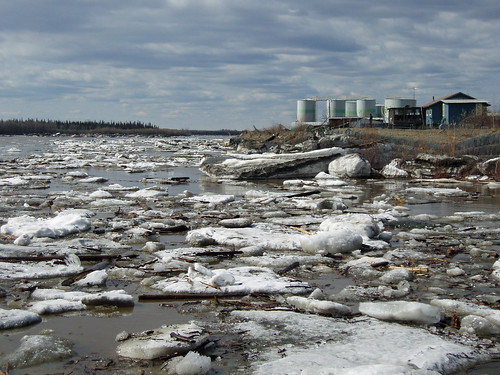
When a flood damaged the banks of the Yukon River in Fort Yukon, Alaska, USDA’s Natural Resources Conservation Service stepped in to help prevent a major environmental catastrophe.
The citizens of Fort Yukon are predominantly Alaskan Natives who live a subsistence lifestyle, relying on fish from the Yukon River as one of their main food sources. The community is not accessible by road and all supplies are either barged in during the short summer or flown in at extreme expense. An entire year’s fuel supply for the village’s vehicles, heating and power is held in a 750,000 gallon tank farm.
In May 2009, a major break-up flood—a spring flood that occurs when the river ice is breaking up—caused widespread bank erosion on the Yukon River. During this type of flood, the ice sometimes forms huge ice jams that can dam the river and make the flooding even more extreme. Fast-flowing water pushes the ice downstream, causing it to scour the banks and plow into buildings.
The flood destroyed a series of finger dikes NRCS had installed in the mid-1990s through its Emergency Watershed Protection Program. Without the dikes the tank farm was left vulnerable to erosion as the tanks were mere feet from the eroding river bank. To save their fuel and protect the river, Fort Yukon residents requested NRCS’s help in replacing the bank protection.

However, stabilizing the bank was impractical. First, NRCS engineers estimated stabilization efforts could run as high as $23 million dollars. That put the project out of reach for both NRCS and the project sponsor, the Gwichyaa Zhee Gwich’in Tribal Government, which would contribute 10 percent of the cost of the project. Equally problematic were the uncertain long-term prospects for any erosion control measures made to the bank.
So relocating the tank farm away from the river bank to a more stable, less flood-prone location seemed the best alternative. The relocation ultimately cost just over $10 million, with the sponsor and a private entity furnishing approximately 20 percent of the funding.
The project prevented what would have been a catastrophic fuel spill into the Yukon River. It protected the village’s infrastructure, helped preserve the subsistence fishing-based lifestyle of Fort Yukon’s residents and protected the water supply of countless people and animals downstream.
Follow NRCS on Twitter
Check out other conservation-related stories on the USDA blog.



